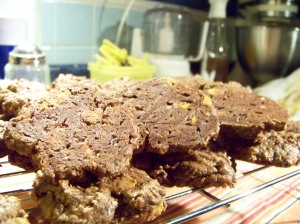Triple Chocolate Cookies with Oats
Qty. approx 48
Notes:
 You can substitute the cocoa and chocolate more to your tastes, and use candy bars if necessary: Natural for the Dutch-processed cocoa; milk chocolate for the unsweetened, etc.
You can substitute the cocoa and chocolate more to your tastes, and use candy bars if necessary: Natural for the Dutch-processed cocoa; milk chocolate for the unsweetened, etc.
You can use any kind of chips you like. These cookies are a good way to empty any open bags of chips laying around. You can also experiment with the amount of chips you use.
If you’re called away, keep the dough cool (but not frozen) until you can finish the batch.
Dry Ingredients
1¾ c. bread flour
¼ c. AP flour
¼ c. Dutch-processed cocoa
1¾ c. oats
1 c. brown sugar
¼ c. white sugar
1 TBL instant espresso
½ tsp baking powder
2 tsp salt
8 oz. white chocolate chips
8 oz. semisweet chips
4 oz. milk chocolate chips
Wet Ingredients and Fats
2 TBL unsalted butter, melted
6 TBL unsalted butter, softened
2 TBL lard or shortening (lard preferred)
3 eggs
1 egg yolk
2 TBL dark corn syrup
2 TBL vanilla (or to taste)
10 oz. bittersweet chocolate, melted
2 oz. unsweetened chocolate, melted
2 TBL vegetable oil
Preheat oven to 350 F. Place rack in the middle; line room temp baking sheets with parchment.
Begin melting chocolate with 1 TBL of the vegetable oil. This can be done in the microwave, or over direct, very low heat. Once melted, mix in cocoa and allow to cool.
While you’re at the stove or microwave, heat up a very small amount of water to add to the instant espresso, then set aside. Then, melt the 2 TBL of butter and set aside to cool. (That’s important!)
While the chocolate is melting, begin assembling the rest of the cookies:
Cream the butter, lard, 1 tsp of the salt and brown sugar in a mixer set to medium. (Use beater attachments.) This will take about four minutes to fluff up and lighten in color a bit. If you need to use a hand mixer for this, that’s fine; no need to worry about timing. Everything can sit for a few extra minutes if necessary.
In a separate mixing bowl, mix your room temp eggs, single yolk, white sugar, corn syrup, vanilla, cooled espresso paste, cooled melted butter and last TBL of salt. (If the butter’s too warm, it’ll cook the eggs. No joke.) Use a whisk to incorporate the ingredients, but gently: Do not incorporate air. If you incorporate too much air, combined with the baking powder your cookies may rise too quickly, the droop and spread.
Allow this mixture to sit for a couple minutes, mix, then repeat once more in another couple minutes.
While the egg mixture sets and activates, assemble the dry ingredients in another bowl: Whisk together flours, oats, baking powder and chips until slightly aerated and well-mixed. This takes less manpower than you think, so be careful not to overmix.
At this point, you can turn around and mix the egg mixture. (You’ll notice that the salt has activated the flavors, sugars, and eggs. Another stir helps this along.) Now, you can incorporate the chocolate into the egg mixture with the same whisk.
Pour the egg/chocolate mixture into the bowl containing the creamed butter and sugar. Mix this on low until incorporated; about 30 seconds or so. This will not be a smooth mixture, so again, don’t overmix.
Finally, add the flour/chip mixture. Use the lowest setting, or mix by hand. A good rule of thumb? Your batters and doughs are usually mixed properly well before you think they are. Overmixing will flatten bakery, making it tough and dense.
Set the dough aside in a cold space to set the dough: About 30 minutes in a freezer, or 1 hour in a fridge or cold mudroom. AC vents are useful for this in warmer climates, too, but if necessary, you can let the dough set on its own at room temperature for a few hours. The melted chocolate will take care of this eventually.
Once set, use a 1½ TBL scoop to place 9 to 12 cookies on the pan. (I always start low in case I’ve done something wrong.) You’ll want to shape these cookies using either your index and middle fingers, or the bottom of your scoop.
Bake for 12 minutes, rotating at the 6-minute mark. You can do these two cookie sheets at a time, too, by using a rack just beneath the middle one. However, this makes rotating the cookies—turning them around and switching racks—very important.
Repeat until finished, using room temp cookie sheets each time. You can re-use the parchment each time so you don’t have to wash them. In fact, I can’t remember the last time I washed my cookie sheets. But you know what? What burns never return, my friends.
Please let me know if you have questions, suggestions, or anything else. Your feedback is important to me!




